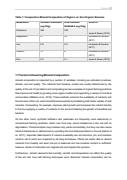Page |7 Table 1: Comparative Mineral Composition of Organic vs. Non-Organic Bananas MINERALS PotassiumORGANIC BANANASNON-ORGANIC (mg/100g)BANANAS (mg/100g) 358352SOURCE Jones & Brown (2019) Magnesium3734Lombardo & Pandino (2017) Iron0.60.5Lombardo & Pandino (2017) Calcium108Lombardo & Pandino (2017) Zinc0.20.1Jones & Brown (2019) 1.7 Factors Influencing Mineral Composition mineral composition is impacted by a number of variables, including as cultivation practices, climate, and soil quality. The nutrients that bananas contain are mostly determined by the quality of the soil. Crop rotation and composting are two examples of organic farming practices that improve soil health by growing more organic matter and supporting a variety of microbial communities (Williams et al., 2016). These methods enhance the availability of nutrients and the structure of the soil, which benefits banana plants by facilitating their better uptake of vital minerals. Composting, for example, improves plant growth and increases the nutrient density in fruit by supplying a variety of nutrients to the soil and fostering the growth of beneficial soil bacteria. On the other hand, synthetic fertilisers and pesticides are frequently used extensively in conventional farming practices, which over time may cause imbalances in the soil and its degradation. Chemical inputs may increase crop yields momentarily, but they can also cause nutrient imbalances or deficiencies by upsetting the microbial populations in the soil (Harris et al., 2017). Important determinants of nutrient availability are soil structure, pH, and moisture content—all of which are impacted by farming techniques. Plants are better able to absorb nutrients from healthy soil when the pH is balanced and the moisture content is sufficient; however, abuse of chemicals can degrade soil and impede this process. Furthermore, climatic elements like humidity, rainfall, and temperature can affect the quality of the soil and how well farming techniques work. Bananas' mineral composition can be
